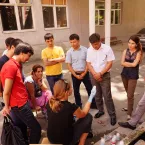Our Research
As climate changes, how do Earth's frozen areas affect our planet and impact society?
In this section
Related News & Stories
Filter by:
Analysis - Sea Ice Today
Arctic sea ice extent declined rapidly the latter half of July, despite the persistence of low sea level pressure over the Arctic Ocean and generally cool conditions.

Feature Story
In 2012, United States Agency for International Development (USAID) funded the University of Colorado Boulder to support the Contribution to High Asia Runoff from Ice and Snow, or CHARIS project. The project seeks to answer the contribution of seasonal snow and glacier melt to paint an accurate picture of the water sources for the High Asia region.

Analysis - Ice Sheets Today
May and June were markedly cooler than the average, although total melt-day area for the ice sheet is near average as of early July. Winds from the south and high air pressure over Iceland caused a spike in melt area in early July.
Analysis - Sea Ice Today
Sea ice declined at a near average rate through the first half of July as low sea level pressure dominated the Arctic Ocean. Wind patterns caused smoke from Siberian forest fires to sweep over the ice.
Analysis - Sea Ice Today
Arctic sea ice extent declined at a slightly slower-than average pace in June. Despite the slow loss, warm conditions and winds from the south developed a large area of open water in the Laptev Sea.

Spotlight
The National Snow and Ice Data Center (NSIDC) is part of the Cooperative Institute for Research in Environmental Sciences at the University